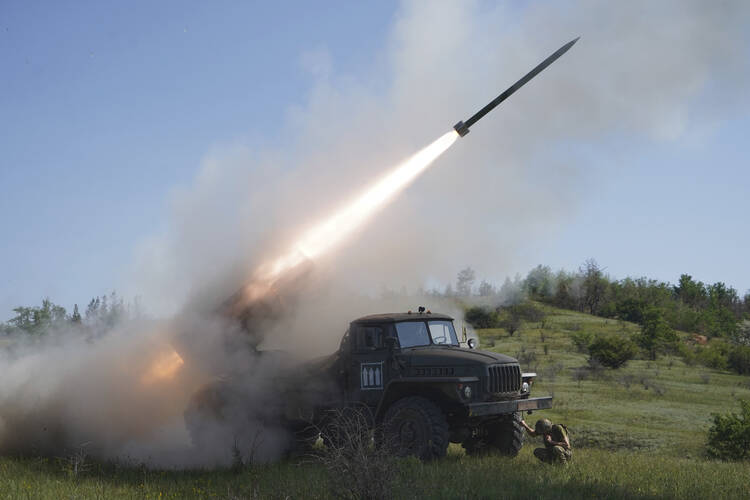An article in Business Insider this week reviews lessons about the future of combat that the Pentagon is likely learning from the war in Ukraine. The U.S. Defense Department has for decades relied on its shock and awe-ful high-tech weaponry to maintain superiority over potential enemies.
But the World War I-style, trench-digging and tank-eating grind in the fields of eastern Ukraine is demonstrating the continuing relevance of low-cost and easy-to-deploy field artillery. When both sides are slogging through the mud and lobbing thousands of rounds at each other each day, it turns out those $100,000 guided shells and multi-billion dollar weapons systems are not the preferred equipment.
So what’s the takeaway for American strategists? Both, we need both! High-tech and low-maintenance; we need everything! Roving satellite-guided howitzers and those low-maintenance, cheap but potent mortar and artillery shells that made the last two great wars so great!
That reflects pretty much a perfect outcome for contemporary arms manufacturers. The war in Ukraine has become the primary driver of a worldwide buying binge as major European powers awaken to the threat of Russian imperialism with unhappy appraisals of their dusty defense capacity.
Sweden had stayed out of European alliances for two centuries. Now, accompanied by Finland, it has joined NATO—ironically precisely the outcome that Russian President Vladimir Putin was warring to prevent. Defense spending in Sweden surged 34 percent last year as it rushed to bring its military up to NATO standards.
Sweden had plenty of company at the checkout counter.
The Stockholm International Peace Research Institute reports record military spending in 2024: “With the war in Ukraine in its third year, military expenditure kept rising across the continent, pushing European military spending beyond the level recorded at the end of the cold war.” The institute reports historic levels of global spending on weapons—$2.7 trillion, a jump of almost 10 percent above spending in 2023 and “the steepest year-on-year rise since at least the end of the cold war.”
The consistent top five spenders—the United States, China, Russia, Germany and India—accounted for 60 percent of the record global total, with combined spending of $1.6 trillion.
It is hard to put dollar figures like that in perspective, but it is fair to say that the global tab for addressing the world’s acute humanitarian or ecological needs pales in comparison to the eye-watering amounts governments unabashedly dole out for bombs and bullets.
Foreign assistance through the recently obliterated U.S. Agency for International Development was about $60 billion in 2024—less than 1 percent of total U.S. spending. (Subtracting about $13 billion in U.S.A.I.D. resources disbursed on military and other assistance to places like Israel, Ukraine and Taiwan from the total means actual total humanitarian and development spending was far less.)
The U.N.’s World Hunger Organization estimates that it would cost about $40 billion annually to end hunger by 2030. Costs for ending global homelessness or illiteracy are harder to estimate but are in the same ballpark. Around $200 billion each year would likely do the trick. That’s about 13 percent of the current annual spending on weapons.
Sadly, spending on poverty reduction, economic development and other social needs has not only stalled, it is rolling backwards in many nations—both domestically and internationally—as a scramble to pay for new weapons begins. The church has unhappily noted the trade-offs.
Twenty U.S. bishops have now signed on to Pax Christi USA’s “Bread not Stones” campaign, deploring the sacrifices that Americans are regularly asked to accept in order to pay for the world’s greatest spending on weapons procurement. They write: “We cannot remain silent while our nation squanders hundreds of billions of dollars every year on weapon systems that add little to our nation’s national security while neglecting the poor and marginalized in our dioceses and around the world.”
The Pax Christi document references Matthew 7:9: “Which of you, if your child asks for bread, will give them a stone?” Its signatory bishops write: “Our poor and marginalized brothers and sisters cry out for the bread of compassion and justice. Shall we continue to offer them stones?”
Through its just war tradition, the church offers some cover to realpolitikers out there who argue that military expenditures represent morally defensible security “investments.” But other church teachings, like its preferential option for the poor, challenge the mighty levels of spending in a world of heartache and want.
In the church’s pastoral constitution from the Second Vatican Council, “The Church in the Modern World,” competition in global arms procurement is described as “one of the greatest curses on the human race; it is to be condemned as a danger, an act of aggression against the poor, and a folly which does not provide the security it promises” (81).
NATO leaders don’t appear to be listening. At a summit planned later this month at the Hague, it is widely expected that alliance leaders will officially retire a previous standard for defense spending by individual NATO states of 2 percent G.D.P., pushing for the acceptance of a new 3.5 percent threshold.
Some countries are already well on their way to that level. The United Kingdom, Poland, France and Germany have all confirmed significant new spending on defense. Canada has become the latest NATO member to ratchet up defense spending.
Prime Minister Mark Carney said on June 9 that Canada will meet NATO’s military spending guideline of 2 percent of G.D.P. by 2026—five years earlier than previously planned, though Mr. Carney assured in a speech at the University of Toronto, “Our goal is to protect Canadians, not to satisfy NATO accountants.”
“Our military infrastructure and equipment have aged, hindering our military preparedness,” he said. Mr. Carney plans what he called investments “in new submarines, aircraft, ships, armed vehicles and artillery, as well as new radar, drones and sensors to monitor the seafloor and the Arctic.”
How much of Canadian nouveau bellicosity is attributable to President Donald Trump’s threats to absorb Canada as the 51st state was left unsaid. But Mr. Carney did note that Canada had become “too reliant on the United States,” both for its defense and for its weapons supply.
Mr. Carney’s government is adding 9 billion Canadian dollars, about $6.6 billion, in defense spending this year. That sounds like a lot of dough, but it is a drop in the bucket compared to what other nations are newly committing to weapons buys.
According to SIPRI, Germany became the world’s fourth biggest spender on defense in 2024, with expenditures reaching $89 billion. That figure was almost 30 percent more than spending in 2023 and 90 percent more than it spent in 2015. Close behind last year was Poland. Its military spending leaped more than 30 percent in 2024 to $38 billion, representing 4.2 percent of G.D.P.
The United States leads the world in annual spending—$997 billion in 2024, according to SIPRI, more than three times the amount spent by second-place China with $314 billion. U.S. defense spending represented about 40 percent of the world total in 2024.
The U.S. Department of Defense uses a narrower calculation than SIPRI, reporting U.S. defense spending of $841 billion last year. The Trump administration plans a significant increase in 2026, vowing to crack the $1 trillion barrier on defense spending at the same time it proposes to lower taxes and implement vast cuts to domestic social spending.
In third place globally, Russia spent an estimated $149 billion on defense in 2024, a 38 percent increase from 2023 and double the level from 2015. The spending represented 7.1 per cent of Russia’s G.D.P. that year. Can it keep up that level of commitment to military spending as the war in Ukraine drags on?
It may only have to outlast poor Ukraine. Its total military expenditures grew by a comparably paltry 2.9 percent in 2024 to reach $64.7 billion—equivalent to 43 percent of Russia’s spending. But because that is 34 percent of Ukraine’s G.D.P., SIPRI reports that Ukraine carried the largest military burden of any country in 2024.
In an era of conflict in the Holy Land, Africa and Europe, Pope Leo has already indicated that peacemaking will be a major preoccupation of his pontificate. Urging, like Popes John Paul II and Paul VI, “war no more” in one of his first public addresses, he called for an “authentic and lasting peace” in Ukraine; a ceasefire in Gaza; and release of all Israeli hostages held by the Palestinian militant group Hamas.
“War is never inevitable,” he said soon after his election. “Weapons can and must be silenced, for they do not resolve problems but only increase them. Those who make history are the peacemakers, not those who sow seeds of suffering.”
The pope warned against simplistic narratives that divide the world into good and evil. “Our neighbors are not first our enemies, but fellow human beings,” he said. He has volunteered the good services of the Holy See to broker a cease-fire in Ukraine.
Pope Francis frequently deplored the global scandal of military spending and the weapons manufacturers whom he suggested pulled geopolitical strings to protect their death-dealing markets. It is likely only a matter of time before Pope Leo will have to lock rhetorical horns with the defenders of the status quo on global conflict and the masters of war who profit from their political leadership.
More from America
- Trump’s foreign aid freeze a ‘death sentence’ for many humanitarian groups
- Ukraine and the troubling future of A.I. warfare
- Cardinal Parolin: Pope Leo wants peace between Russia and Ukraine, not a role in negotiations
A deeper dive
- Canada to Boost Military Spending to Try to Placate Trump
- A trillion dollars annually for the Pentagon: Military spending is out of control
- Unprecedented rise in global military expenditure as European and Middle East spending surges
- The United States Spends More on Defense than the Next 9 Countries Combined
The Weekly Dispatch takes a deep dive into breaking events and issues of significance around our world and our nation today, providing the background readers need to make better sense of the headlines speeding past us each week. For more news and analysis from around the world, visit Dispatches.








